Nanotechnology Incorporation into Road Pavement Design Based on Scientific Principles of Materials Chemistry and Engineering Physics Using New-Age (Nano) Modified Emulsion (NME) Stabilisation/Enhancement of Granular Materials
Abstract
:Featured Application
Abstract
1. Introduction
- Enable naturally available materials to be fully utilized at a fraction of the cost of imported, newly crushed stone;
- Meet the engineering requirements in terms of fundamental physics, i.e., stresses, strains and durability;
- Accommodate ease of use to be applied within a low-risk environment without compromising quality.
2. Background—Primary Benefits of the Introduction of New-Age Nanotechnology Solutions (Nano-Silanes) in Pavement Materials Design in Pavement Layers
- Cost factors: naturally available materials can be used at a low risk with an enhanced durability, reducing materials costs with savings in the procurement, transportation and construction costs associated with high quality crushed stone;
- Environmental factors: naturally available materials require less energy for production, i.e., the blasting, transportation, crushing and screening is normally not required. New-age (Nano) Modified Emulsions (NME) stabilisation eliminates the use of cement (the manufacturing of which is a considerable contributor to greenhouse gasses in the world, with an additional associated cost of around USD 70 to USD 80 per ton during manufacturing);
- Energy factors: the constructability of NME stabilisation is less complex, requiring considerably less compaction effort, i.e., energy (due to the introduction of a lubricant as part of the NME), compared to traditional high quality crushed stone layers and requires no heating when added as part of the construction water, resulting in considerable savings in energy.
3. Pavement Design Process Based on Scientific Principles
3.1. Elements Comprising the Design Approach
3.2. Scientifically Based Material Properties of Naturally Available Materials
3.2.1. Mineralogy of Naturally Available Materials
- Original rock formation and primary minerals;
- Climatic factors including rainfall, temperature and humidity;
- Changes in the slope of the area and vegetation that both contribute to the removal of the top, most weathered materials through the flow of water;
- Human interference through deforestation and other activities.
3.2.2. Primary Minerals Defining the Type of Stone
3.2.3. Secondary Minerals Defining the Condition of the Stone
- The size of the molecule of the stabilising agent;
- The size of the particle of the nano-silane modification of the stabilising agent;
- The practical considerations during construction.
3.3. Identification of Scientifically Abased Material Characteristics
- Maximum Dry Density (MDD);
- Optimum Moisture Content (OMC);
- Grading of the material properties. Of particular importance is the percentage of the material passing the 0.075 mm sieve and the grading of these fine particles. Hydrometer tests (not normally available in field laboratories) will give an indication of the silt and clay fractions. However, these tests will give no indication of the mineralogy or the type of clay present in the material.
3.4. Identification of a Material Compatible NME Stabilising Agent
- Material-compatible applicable nano-silane modifier of a volume and dimension suitable to ensure that the required hydrophobicity is achieved, while also providing strong chemical bonds between the material particles and the stabilising agent;
- Compatible, applicable stabilising agent to be selected with the required grading to ensure that all material particles are bonded together in a stable, durable material, meeting the fundamental engineering requirements/criteria/specifications.
- Primary mineral: Silicate material;
- CBR @ 95% mod AASHTO = 35;
- Percentage passing the 0.075 mm sieve = 16%;
- Percentage clay, mica and talc as a fraction passing the 0.075 mm sieve = 30%.
- Figure 20, giving a relative increase in nano-silane modification in terms of the required coverage area as indicated by the example using a combination of nano-silane (X) and sub-nano-size (Pico) silane (Y) to cover the increase in area presented by the decrease in material particle size;
- Figure 21 as an indication of the applicable stabilising agent in terms of a micro-size and nano-size stabilising agent.
- Zone 1: 0.1% to 0.2% per mass;
- Zone 2: 0.7% to 1.5% per mass;
- Zone 3A: 0.4% to 1.0% per mass;
- Zone 3B: Specialist design.
3.5. Required Fundamental Engineering Properties
3.5.1. Stresses, Strains and Durability
3.5.2. Recommended Test Protocols
- The time periods and temperature for a rapid curing process for the stabilisation should be standardised. However, it is well known that some polymers are damaged at temperatures exceeding 50 °C. Hence, the rapid curing process should be performed at temperatures between 40 °C and 45 °C (allowing for natural variations in remote or field laboratories as commonly experienced in practice);
- No special treatment of material samples, e.g., soaking in the stabilising agent after curing should be allowed;
- No treatment of the sample compaction moulds to assist with the removal of samples, e.g., the use of oil or grease, should be allowed, as this could influence the results obtained during the soaking of the sample in water;
- Rapid curing process pre- and post-treatments before testing must be standardised.
- The curing and testing process of the 152 mm diameter samples (127 mm high) shall be as follows: The prepared 152 mm diameter by a 127 mm height samples are to be prepared as per SANS PART 3001 GR50 [45] and GR51 [46] with some adjustments based on the requirements for a generalised procurement process, with no plastic covering. (Plastic covering is required when cement is included in the mix to assist in the hydration of the cement.) Samples are cured for 24 h in an oven at 30 °C before being subjected to a “rapid curing” process in an oven for 48 h at 40 °C to 45 °C (temperatures in the oven should NOT exceed 50 °C).
- After 48 h, the samples must be removed from the oven and allowed to cool down for 24 h. This is to be preferably performed in the oven at 30 °C for 24 h.
- Three (3) samples must be crushed to determine the ITS and UCS values. The values obtained are called the DRY ITS and the DRY UCS values.
- Three (3) samples must be placed in a bath of water with a temperature of 22–25 °C for four (4) hours (as per test procedure specified for the testing of cementitious stabilising agents (SANS 3001-GR53 [47] and GR 54 [48], as adjusted)) and thereafter removed from the bath and allowed to drain off excess water before determining the WET ITS and WET UCS values.
- If so approved by the Engineer, the “wet” tests (UCS and ITS) may suffice during the quality control during construction. For the lower-order roads (Category D and E), DCP tests performed at randomly selected spots may be approved for quality control as approved by the Engineer (refer to Figure 25).
- During the design stage, three samples each must be preserved outside the moulds for a period of 28 days. After 28 days, the UCS (wet and dry), as well as the ITS (wet and dry), should be tested as per the procedure described above. The results of the 28-day tests should not show a decrease of more than 5 per cent in the values of the respective UCS and ITS tests as compared to that obtained after the rapid curing process.
- It is important to note that sample preparation must be performed in strict compliance with the prescribed procedures and NO deviation will be allowed, including:
- 7.1
- The moulds in which the samples are prepared are not to be treated with grease or any other lubricant to facilitate the easy removal of the sample, as this could influence the loss (during rapid curing) or increase (during soaking in water) of moisture and hence the measurements of UCS and ITS both in the dry and wet conditions;
- 7.2
- No additional soaking of samples in any “covering” liquid or any other material will be allowed, as this will make any comparison and application of test requirements invalid and not comparable to what is practically achievable during construction.
4. Typical Pavement Structural Designs Recommended for a Variation of Traffic Loadings and Traditionally Defined Subgrade Materials
5. Practical Application and Comparison of Material Design Methods/Approaches
5.1. Design Method: Comparison of Results
5.2. Discussion of Results
6. Conclusions
Author Contributions
Funding
Institutional Review Board Statement
Informed Consent Statement
Data Availability Statement
Acknowledgments
Conflicts of Interest
References
- Von Ebelman, J.J. Untersuchungen über die Verbinddungender Borsäure mit Aetther. Ann. Chem. Pharm. 1846, 57, 319–353. [Google Scholar] [CrossRef]
- Von Hoffman, W. Stone-preserving processes: Royal Institute of British Architects. Builder 1861, 19, 103–105. [Google Scholar]
- Wheeler, G. Alkoxysilanes and the Consolidation of Stone; The Getty Conservation Institute: Los Angeles, CA, USA, 2005. [Google Scholar]
- Jordaan, G.J.; Steyn, W.J. A Comprehensive Guide to the Use of Applicable and Proven Nano-Technologies in the Field of Road Pavement Engineering Design and Construction; Department of Civil Engineering, University of Pretoria: Pretoria, South Africa, 2019; ISBN 978-0-620-83022-5. [Google Scholar]
- Steyn, W.J. Potential applications of nanotechnology in pavement engineering. J. Transp. Eng. 2009, 135, 764–772. [Google Scholar] [CrossRef] [Green Version]
- Jordaan, G.J.; Kilian, A. The cost-effective upgrading, preservation and rehabilitation of roads—Optimising the use of available technologies. In Proceedings of the 2016 Southern Africa Transportation Conference (SATC 2016), Pretoria, South Africa, 4–7 July 2016. [Google Scholar]
- Weinert, H.H. The Natural Road Construction Materials of Southern Africa; National Book Printers: Cape Town, South Africa, 1980. [Google Scholar]
- British Standards Institution. Selection of road aggregates in the field. In British Standard BS 882; British Standards Institution: London, UK, 1954. [Google Scholar]
- South African Bureau of Standards. Aggregate from natural sources. In SABS Specifications 1083–1976 (as Amended 1979); South African Bureau of Standards: Pretoria, South Africa, 1976. [Google Scholar]
- Jordaan, G.J.; Steyn, W.J. Testing of granular/soil characteristics for the optimisation of pavement designs using reactive stabilising agents including “new-age” nano-technologies. In Proceedings of the 12th Conference of Asphalt Pavements for Southern Africa (CAPSA 2019), Sun City, South Africa, 13–16 October 2019. [Google Scholar]
- Jordaan, G.; Steyn, W.J. Basic chemistry explaining engineering properties of new-age (nano) modified emulsion (NME) stabilised naturally available road pavement materials. Preprints 2021, 28, 2021070627. [Google Scholar] [CrossRef]
- Jordaan, G.J.; Steyn, W.J. Fundamental principles ensuring successful implementation of new-age (nano) modified emulsions (NME) for the stabilisation of naturally available materials in pavement engineering. Appl. Sci. 2021, 11, 1745. [Google Scholar] [CrossRef]
- Jordaan, G.J.; Kilian, A.; Du Plessis, L.; Murphy, M. The development of cost-effective pavement design approaches using mineralogy tests with new nano-technology modifications of materials. In Proceedings of the 2017 Southern Africa Transportation Conference (SATC 2017), Pretoria, South Africa, 10–13 July 2017. [Google Scholar]
- Mshali, M.R.; Visser, A.T. Influence of Mica on Unconfined Compressive Strength of a cement-treated weathered granite gravel. In Proceedings of the Southern African Transportation Conference (SATC 2013), Pretoria, South Africa, 8–11 July 2013. [Google Scholar]
- Porto, M.; Caputo, P.; Loise, V.; Eskandarsefat, S.; Teltayev, B.; Rossi, C.O. Bitumen and bitumen modification: A review on latest advances. Appl. Sci. 2019, 9, 742. [Google Scholar] [CrossRef] [Green Version]
- Caputo, P.; Porto, M.; Angelico, R.; Loise, V.; Calandra, P.; Rossi, C.O. Bitumen and asphalt concrete modified by nanometer-sized particles: Basic concepts, the state of the art and future perspectives of the nanoscale approach. Adv. Colloid Interface Sci. 2020, 285, 102283. [Google Scholar] [CrossRef] [PubMed]
- Rust, F.C.; Mahoney, J.P.; Sorenson, J. An international view of pavement engineering. In Proceedings of the 1998 Meeting of the Bearing Capacity of Roads and Airfields Conference, Trondheim, Norway, 6–8 July 1998. [Google Scholar]
- Jordaan, G.J.; Steyn, W.J. Cost-Effective Upgrading of Gravel Roads Using Naturally Available Materials with New-Age Modified Emulsion (NME) Stabilisation; Department of Civil Engineering, University of Pretoria: Pretoria, South Africa, 2020; ISBN 978-0-620-91415-4. [Google Scholar]
- National Centre for Asphalt Technology (NCAT). Effects of Nanotac Additive on Bond Strength and Moisture Resistance of Tach Coats; NCAT: Auburn, AL, USA, 2011. [Google Scholar]
- Murphy, M.; Jordaan, G.J.; Modise, T.; Dryburgh, R.C.L. The influence of the characteristics of emulsifying agents on the stabilisation of granular materials using nano-silane modified bitumen emulsions. In Proceedings of the 12th Conference of Asphalt Pavements for Southern Africa (CAPSA 2019), Sun City, South Africa, 13–16 October 2019. [Google Scholar]
- Jordaan, G.J. Optimisation of Flexible Road Pavement Rehabilitation Investigations and Design; Department of Civil Engineering, University of Pretoria: Pretoria, South Africa, 2013; ISBN 978-1-77592-036-6. Available online: https://www.lulu.com/ (accessed on 13 August 2021).
- American Association of State and Highway Transportation Officials (AASHTO). M145-91: Standard Specification for Classification of Soils and Soil-Aggregate Mixtures for Highway Construction Purposes; AASHTO: Washington, DC, USA, 1995. [Google Scholar]
- American Society for Testing Materials (ASTM). D3282-09: Standard Practice for Classification of Soils and Soil-Aggregate Mixtures for Highway Construction Purposes; ASTM: West Conshohocken, PA, USA, 2009. [Google Scholar]
- Jordaan, G.J.; Kilian, A.; Machiavelli, N.; Dlamini, D. Practical Application of Nano-Technology in Roads in Southern Africa. In Proceedings of the 8th Transportation Technology Transfer (T2) Conference, Lusaka, Zambia, 4–8 March 2017. [Google Scholar]
- Akhalwaya, I.; Rust, C.F. Laboratory evaluation of road construction materials enhanced with nano-modified emulsions (NME). In Proceedings of the Southern African Transportation Conference (SATC’18), Pretoria, South Africa, 9–12 July 2018. [Google Scholar]
- Rust, F.C.; Akhalwaya, I.; Jordaan, G.J.; Du Plessis, L. Evaluation of a nano-silane-modified emulsion stabilised base and subbase under HVS traffic. In Proceedings of the 12th Conference on Asphalt Pavements for Southern Africa (CAPSA 2019), Sun City, South Africa, 13–16 October 2019. [Google Scholar]
- Rust, F.C.; Smit, M.A.; Akhalwaya, I.; Jordaan, G.J.; Du Plessis, L. Evaluation of two nano-silane-modified emulsion stabilised pavements using accelerated pavement testing. Int. J. Pavement Eng. 2020. [Google Scholar] [CrossRef]
- Netterberg, F. Pedocretes; RR430; National Institute of Transport and Road Research (NITRR), CSIR: Pretoria, South Africa, 1985. [Google Scholar]
- Study.com. Silicate Minerals: Chemical Classification & Examples. 2013. Available online: http://study.com/adademy/lessons/silicate-minerals-chemical-classification (accessed on 13 August 2021).
- Fleisher, M. Recent Estimates of the Abundances of the Elements in the Earth’s Crust; United States Department of the Interior, Geological Survey Circular 285, U.S. Geological Survey: Washington, DC, USA, 1953. [Google Scholar]
- Earle, S. Physical Geology, 2nd ed.; BCcampus: Vancouver, BC, Canada, 2019. [Google Scholar]
- Jones, A.; Breuning-Madsen, H.; Brossard, M.; Daampha, A.; Deckers, J.; Dewitte, O.; Gallali, T.; Hallett, S.; Jones, R.; Kilasara, M.; et al. Soil Atlas of Africa, European Commission; Publication Office of the European Union: Luxembourg, 2013; p. 176. [Google Scholar]
- Harrison, A.D.; Whale, T.F.; Carpenter, M.A.; Holden, M.A.; Neve, L.; O’Sullivan, D.; Temprado, J.V.; Murray, B.J. Not all feldspars are equal: A survey of ice nucleating properties across the feldspar group of minerals. Atmos. Chem. Phys. 2016, 16, 10927–10940. Available online: www.atmos-chem-phys.net/16/10927/2016/ (accessed on 13 August 2021). [CrossRef] [Green Version]
- Morin, W.J.; Toder, P.C. Laterite and Lateritic Soils and Other Problem Soils of Africa; Lyon Association Inc.: Kumisasi, Ghana, 1971. [Google Scholar]
- Geological Society Engineering Group Working Party. The description of rock masses for engineering purposes. Q. J. Eng. Geol. 1977, 10, 355–388. [Google Scholar] [CrossRef]
- Geological Society Engineering Group Working Party. Tropical residual soils Geological Society Engineering Working Party Report. Q. J. Eng. Geol. 1990, 23, 4–101. [Google Scholar] [CrossRef]
- Food and Agriculture Organisation of the United Nations (FAO). FAO/UNESCO Soil Map of the World. 2021. Available online: http://www.fao.org/soils-portal/data-hub/soil-maps-and-databases/faounesco-soil-map-of-the-world/en/ (accessed on 13 August 2021).
- African Community Access Programme (AFCAP). Review of Specifications for the Use of Laterite in Road Pavement Construction in the SADC Region; Funded by the United Kingdom Department for International Development (DFIN), The Association of Southern African National Roads Agencies (ASANRA) under the Aegis of the Africa Community Access Programme (AFCAP); Africa Community Access Programme (AFCAP): Gaborone, Botswana, 2014. [Google Scholar]
- Tuncer, E.R. Engineering Behaviour and Classification of Lateritic Soils in Relation to Soil Genesis. Ph.D. Thesis, Iowa State University, Ames, IA, USA, 1976. [Google Scholar]
- Kumari, N.; Chandra Mohan, C. Basics of Clay Minerals and Their Characteristic Properties; IntechOpen: London, UK, 2021; Available online: www.intechopen.com (accessed on 13 August 2021). [CrossRef]
- Moore, J.E. Clay mineralogy problems in oil recovery. Pet. Eng. 1960, 32, 78–101. [Google Scholar]
- Power Chemical Corporation (PCC). Silane Coupling Agents Guide; PCC: Nanjing, China, 2009. [Google Scholar]
- Asphalt Academy. Technical Guidelines: TG2: Bitumen Stabilised Materials: A Guideline for the Design and Construction of Bitumen Emulsion and Foam Bitumen Stabilised Materials, 2nd ed.; Asphalt Academy: Pretoria, South Africa, 2009; ISBN 978-0-7988-5582-2. [Google Scholar]
- Jordaan, G.J. Behaviour of an Emulsion Treated Base (ETB) layer as determined from Heavy Vehicle Simulator (HVS) testing. In Proceedings of the 10th Conference on Asphalt Pavements for Southern Africa (CAPSA 2011), Drakensberg, South Africa, 11–14 September 2011. [Google Scholar]
- South African National Standards (SANS). SANS 3001: Civil Engineering Test Methods—GR50: Preparation, Compaction and Curing of Specimens of Laboratory Mixed of Cementitiously Stabilised Materials; SABS Standards Division: Pretoria, South Africa, 2013. [Google Scholar]
- South African National Standards (SANS). SANS 3001: Civil Engineering Test Methods—GR51: Preparation, Compaction and Curing of Field Mixed Freshly Cementitiously Stabilised Materials Including the Determination of the Maximum Dry Density and Optimum Moisture Content; SABS Standards Division: Pretoria, South Africa, 2015. [Google Scholar]
- South African National Standards (SANS). SANS 3001: Civil Engineering Test Methods—GR53: Determination of the Unconfined Compressive Strength of Compacted and Cured Specimens of Cementitiously Stabilised; SABS Standards Division: Pretoria, South Africa, 2010. [Google Scholar]
- South African National Standards (SANS). SANS 3001: Civil Engineering Test Methods—GR54: Determination of the Indirect Tensile Strength of Compacted and Cured Specimens of Cementitiously Stabilised Materials; SABS Standards Division: Pretoria, South Africa, 2010. [Google Scholar]
- Jordaan, G.J.; Steyn, W.J.; Broekman, A. Evaluation of cost-effective modified binder thin chip and cape seal surfacings on an anionic nano-modified emulsion (NME)-stabilised base layer using accelerated pavement testing (APT). Appl. Sci. 2021, 11, 2514. [Google Scholar] [CrossRef]
- Highway Research Board (HRB). The AASHO Road Test; National Academy of Science—National Research Council: Washington, DC, USA, 1962. [Google Scholar]
- Jordaan, G.J. Life-cycle cost analysis—An integral part of pavement rehabilitation design. In Proceedings of the 10th Conference on Asphalt Pavements for Southern Africa (CAPSA 2011), Drakensberg, South Africa, 11–14 September 2011. [Google Scholar]
- Committee of Land Transport Officials (COLTO). Draft TRH4: Structural Design of Flexible Pavements for Interurban and Rural Roads; National Institute for Transport and Road Research (NITRR), CSIR: Pretoria, South Africa, 1996. [Google Scholar]
- Committee of Land Transport Officials (COLTO). Draft TRH14: Guidelines for Road Construction Materials; National Institute for Transport and Road Research (NITRR), CSIR: Pretoria, South Africa, 1985. [Google Scholar]
- Southern African Bitumen Association (SABITA). Technical Guidelines: TG2: Bitumen Stabilised Materials: A Guideline for the Design and Construction of Bitumen Emulsion and Foam Bitumen Stabilised Materials, 3rd ed.; Howards Place: Cape Town, South Africa, 2020; ISBN 978-1-874968-77-1. [Google Scholar]
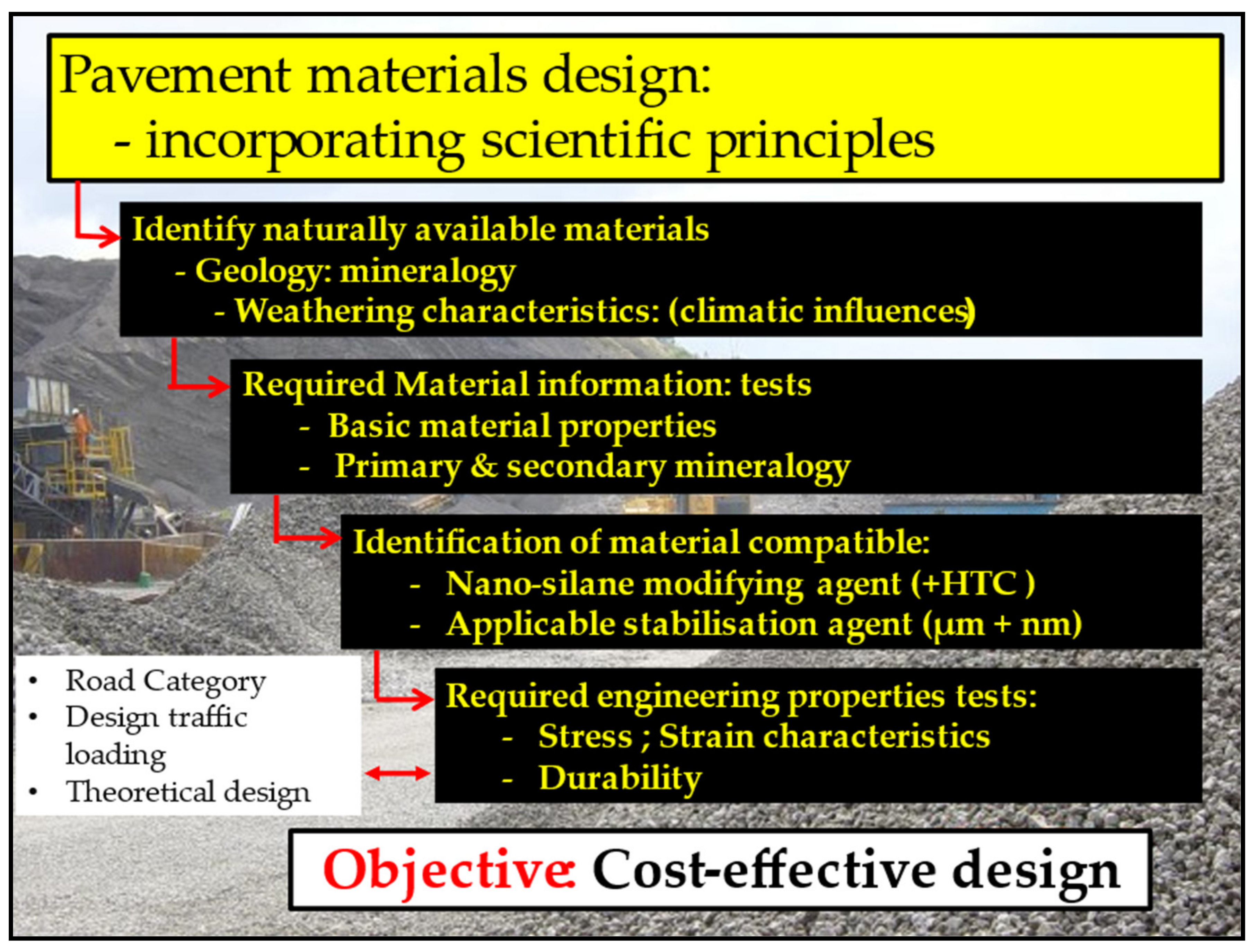
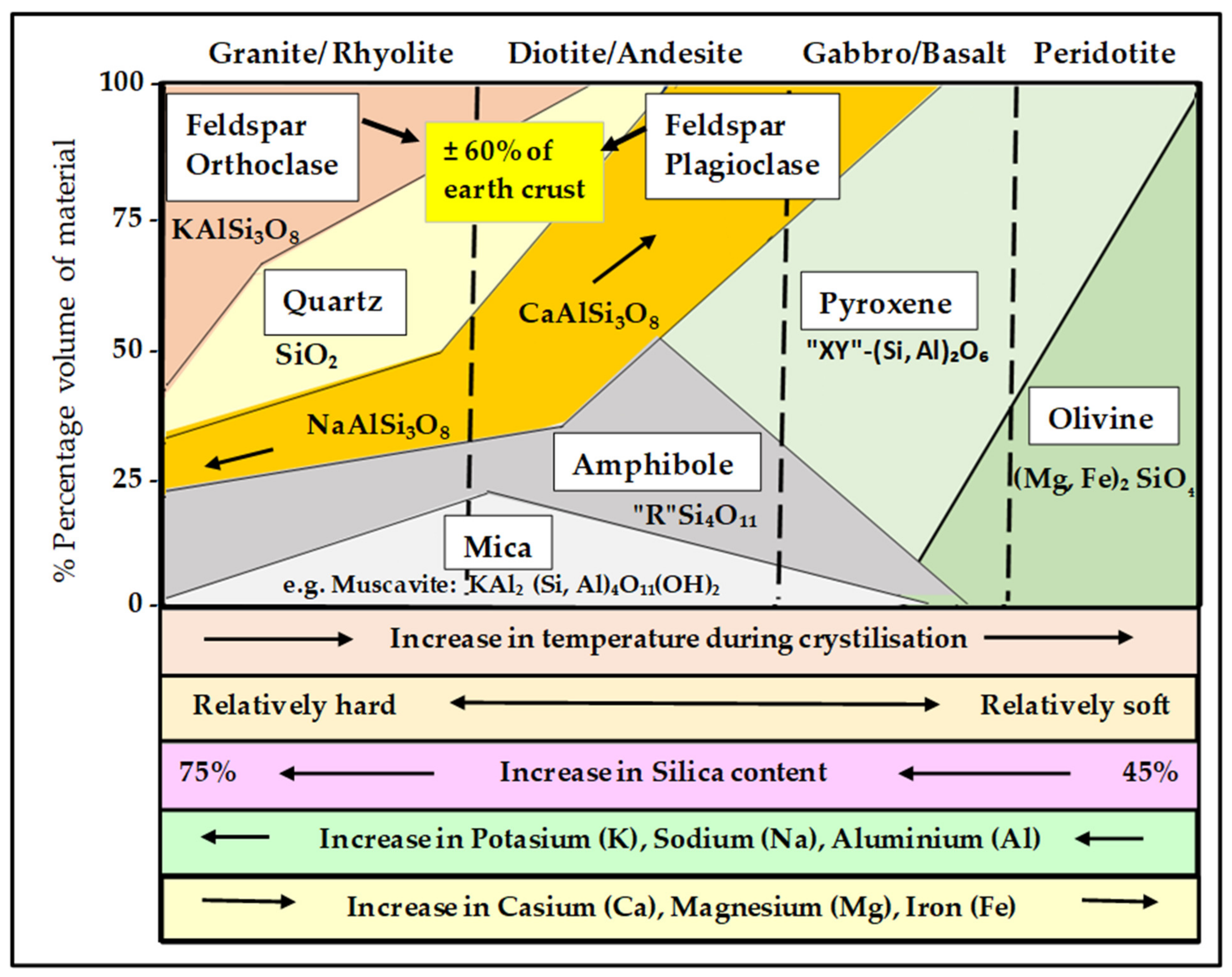


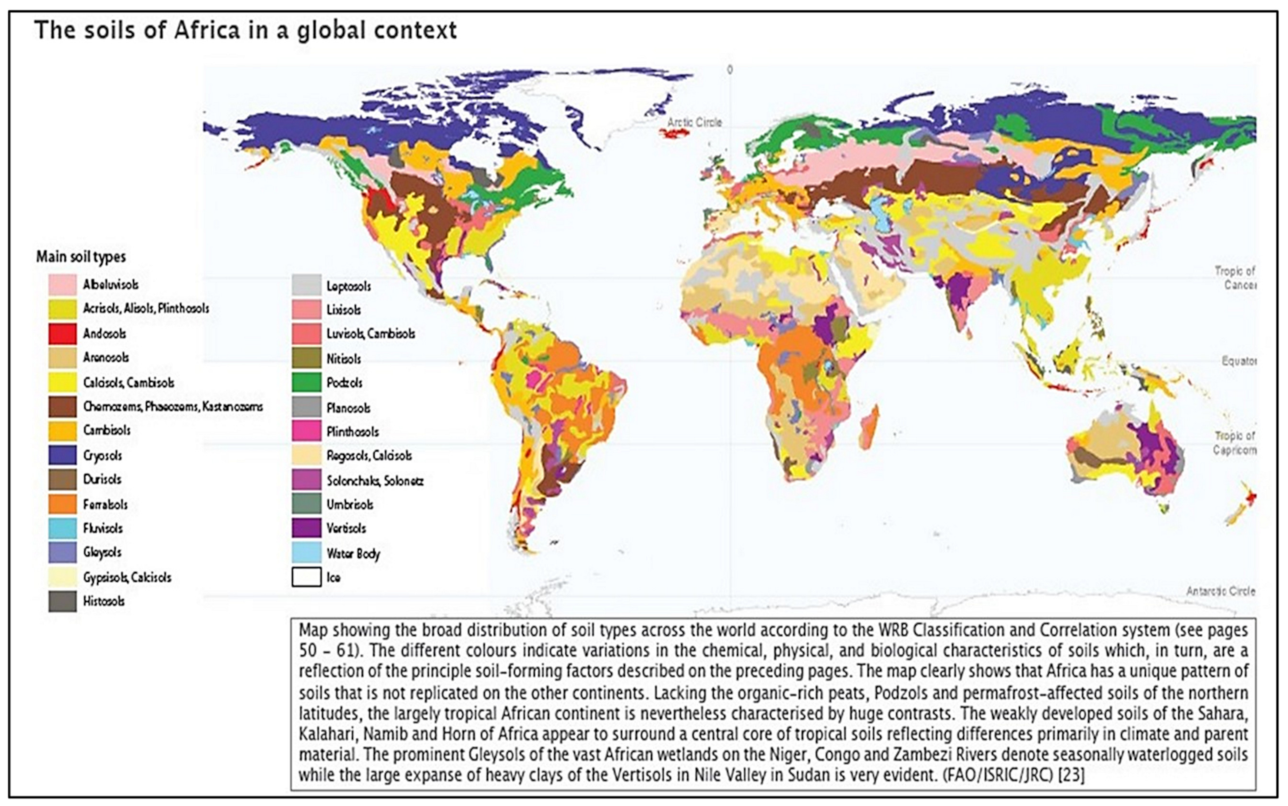
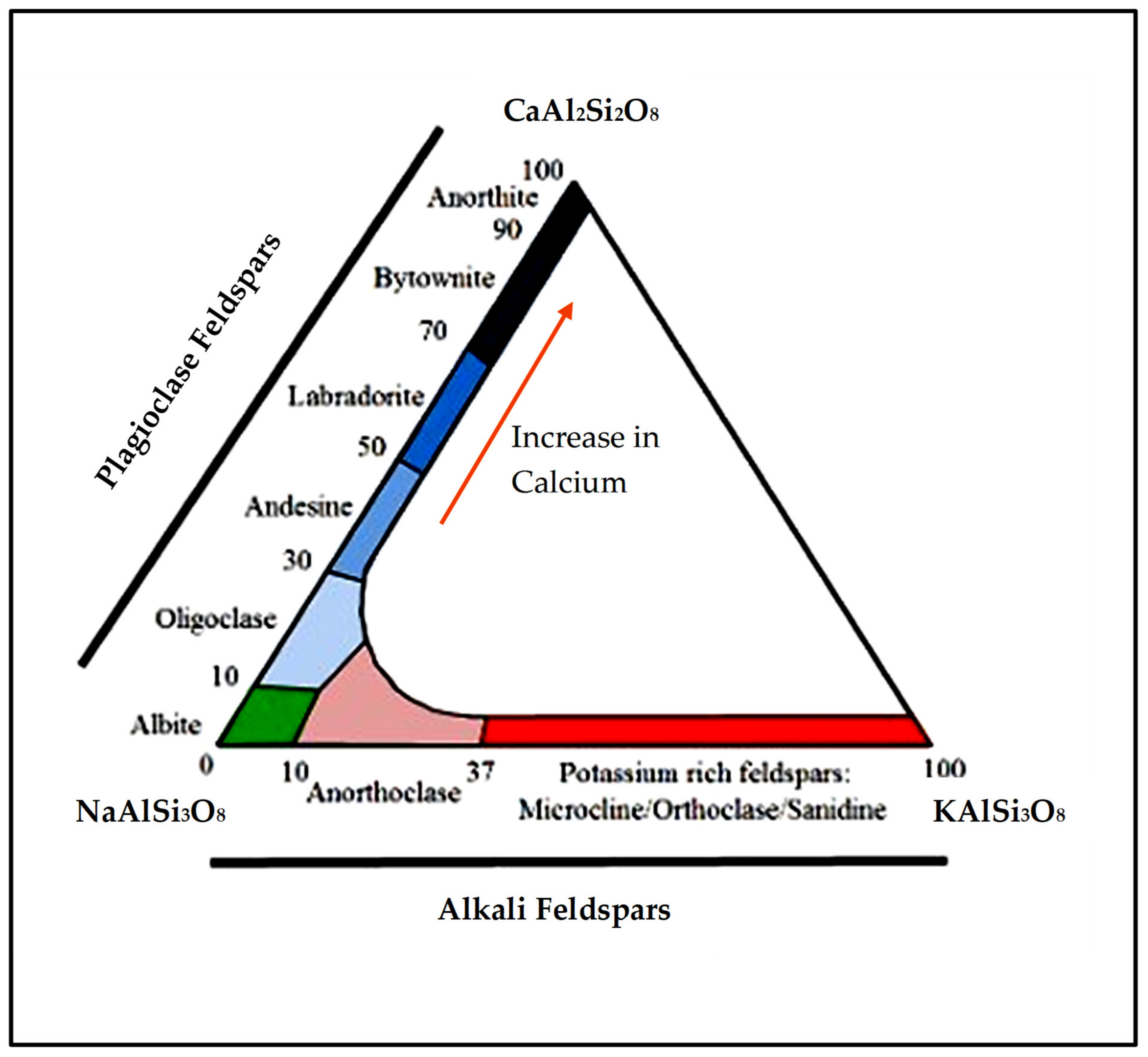
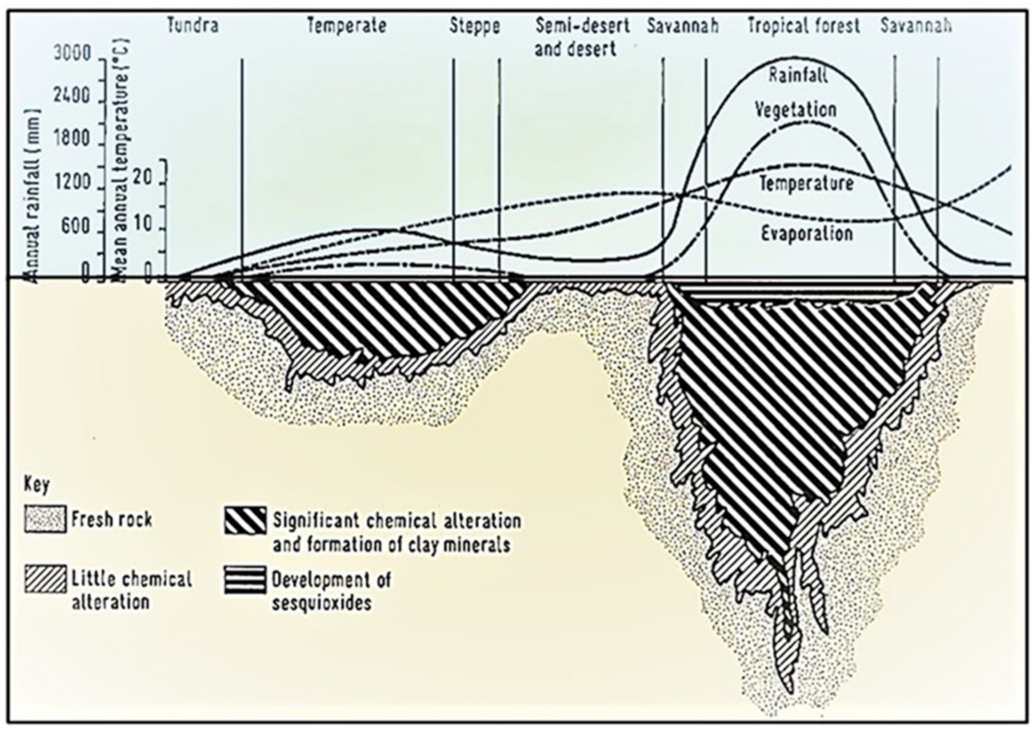

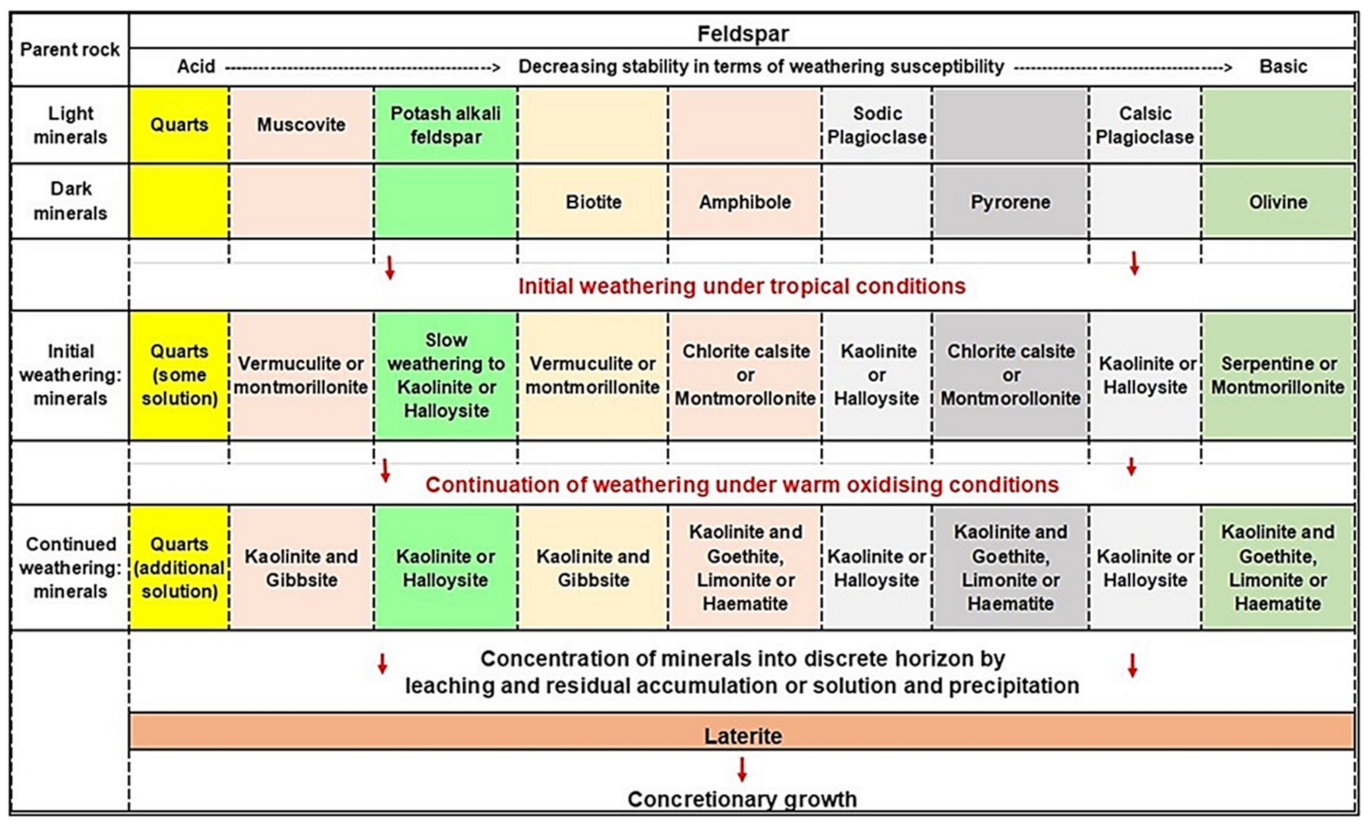
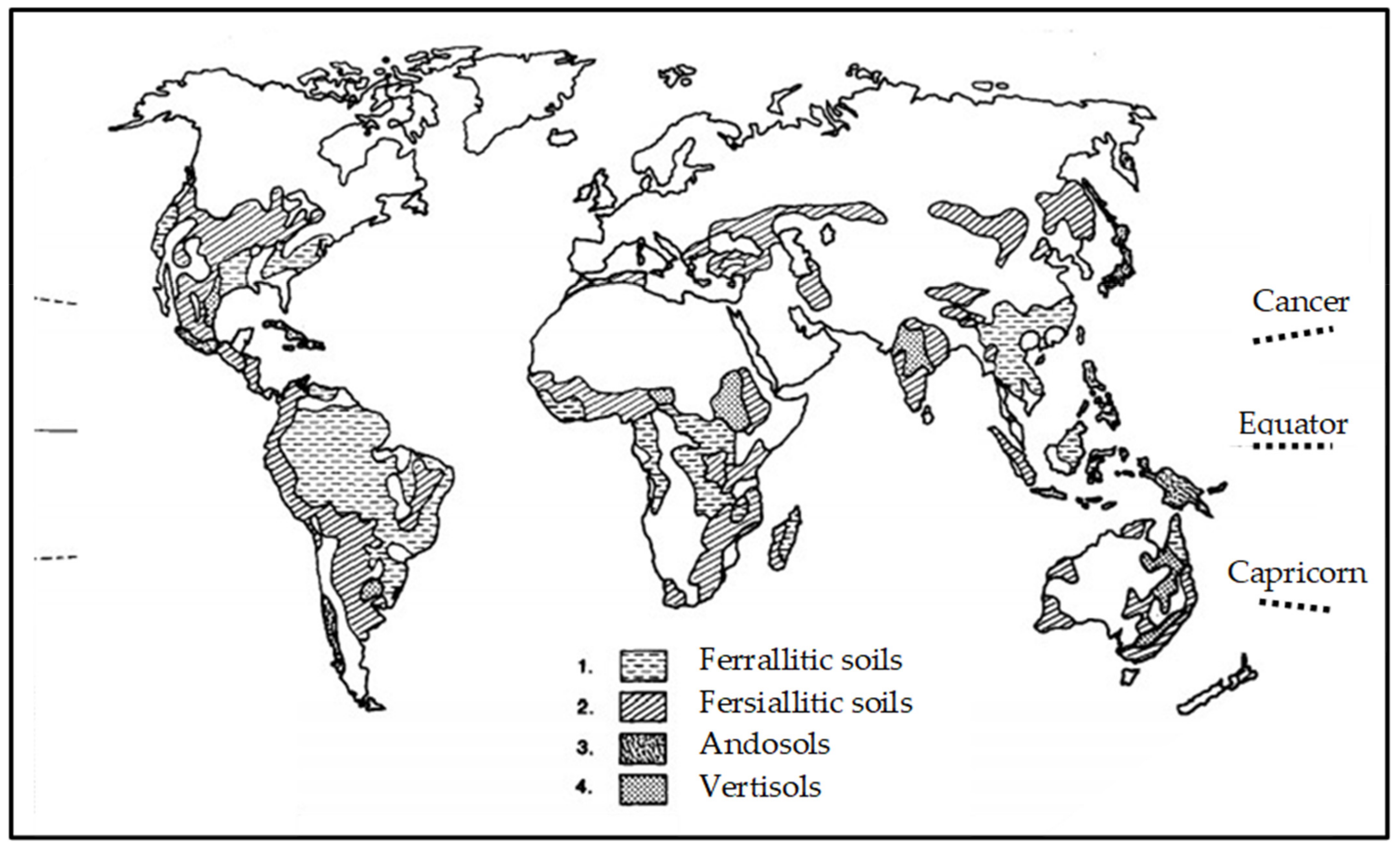



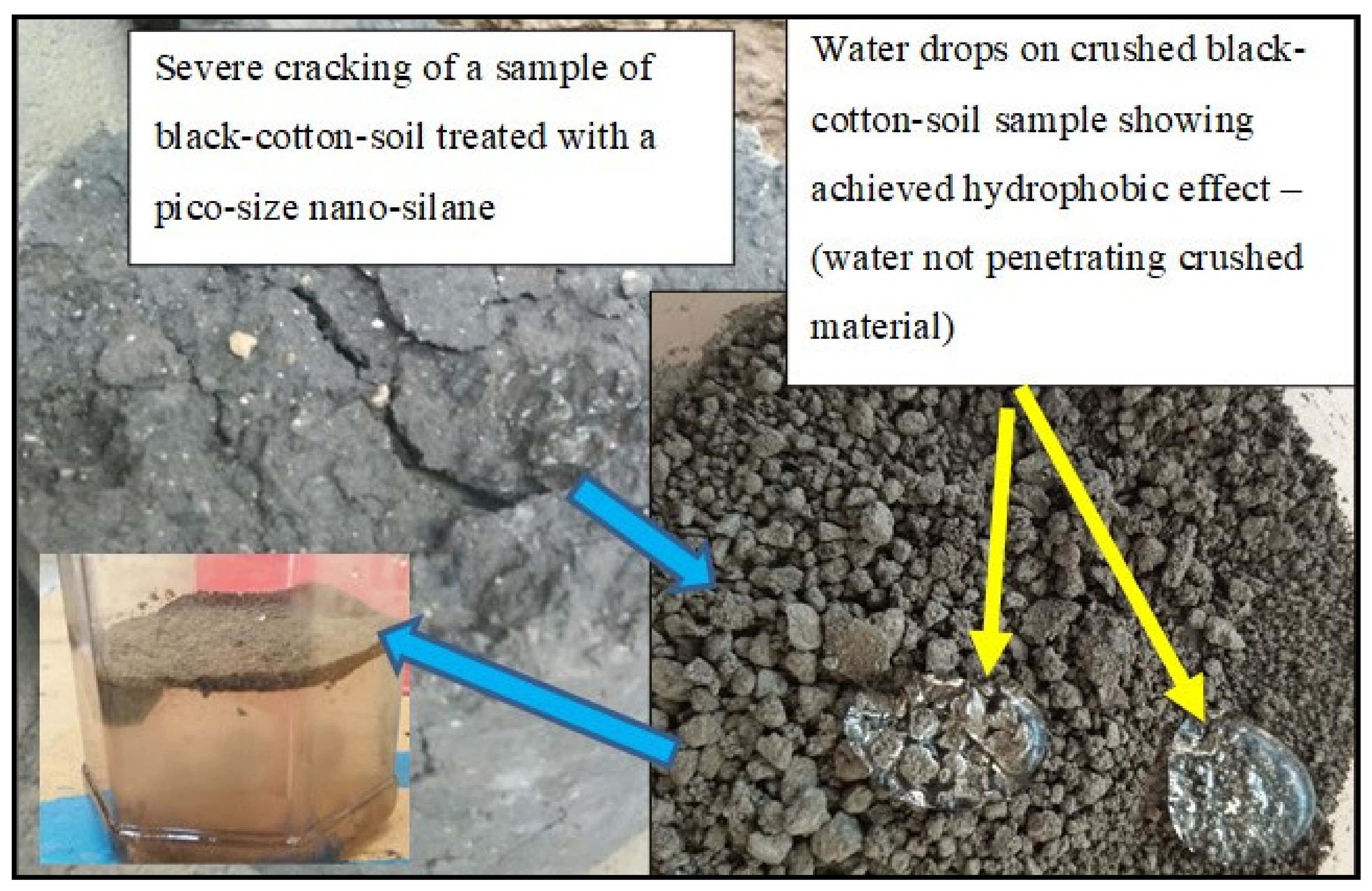
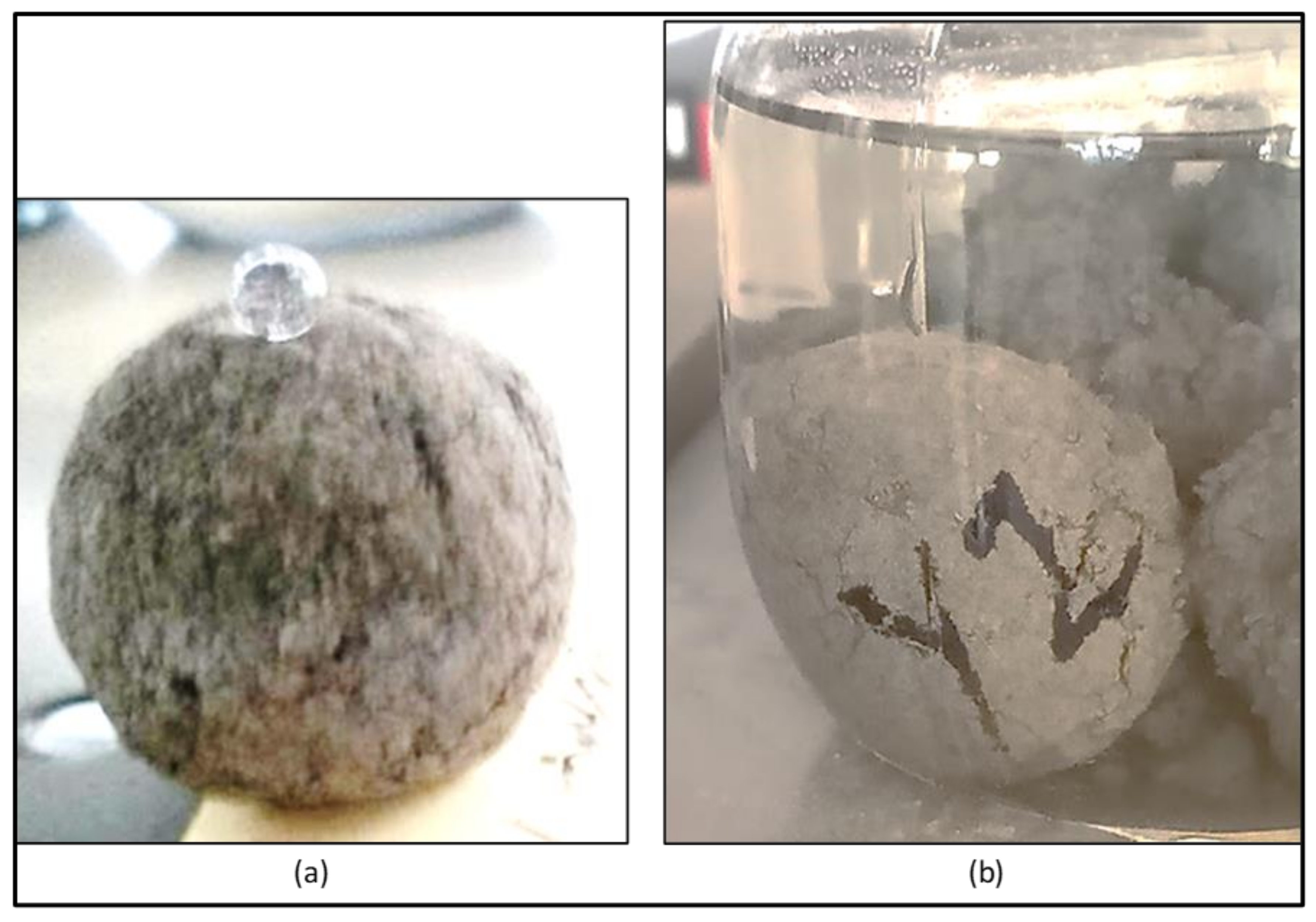
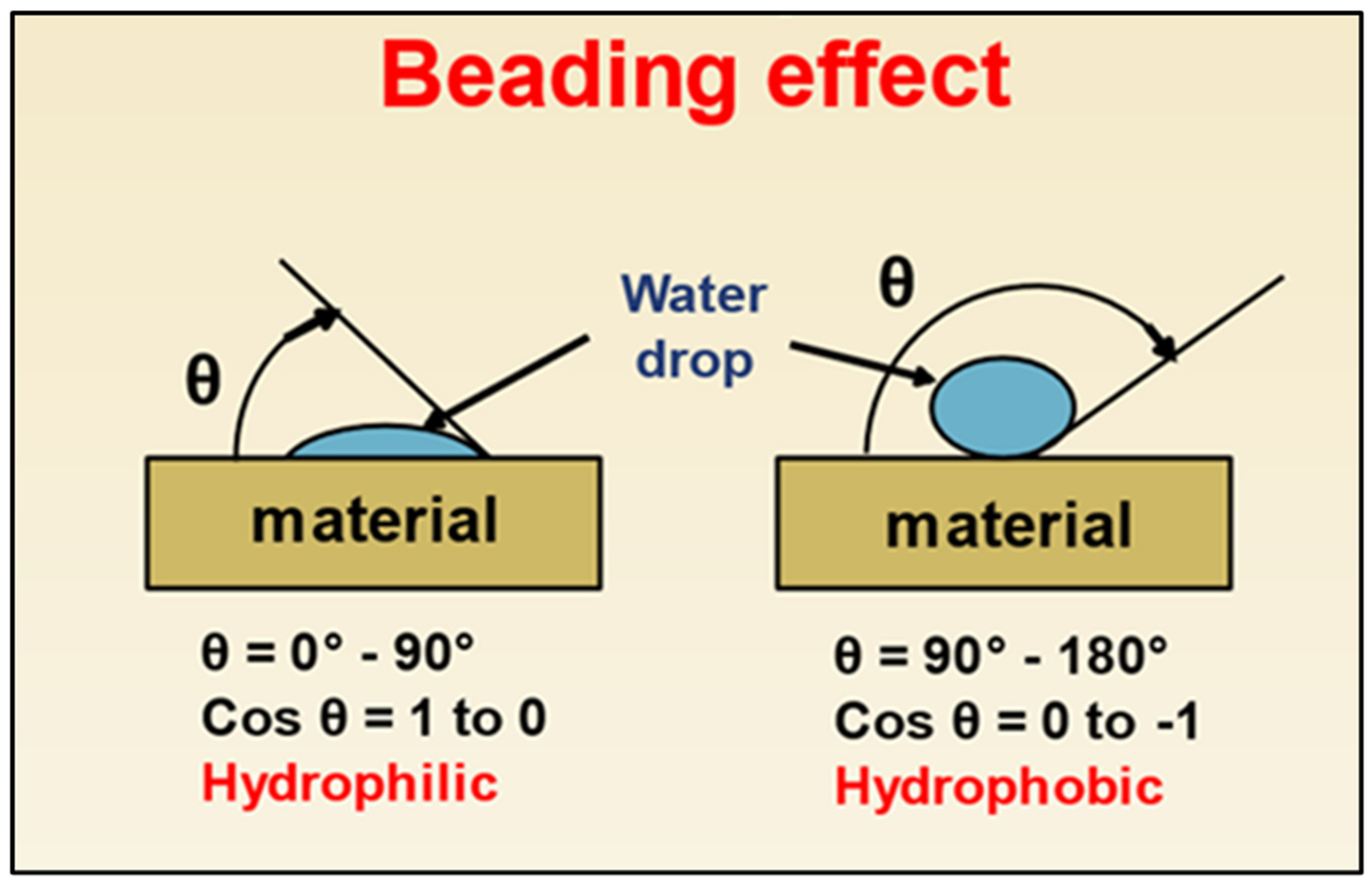


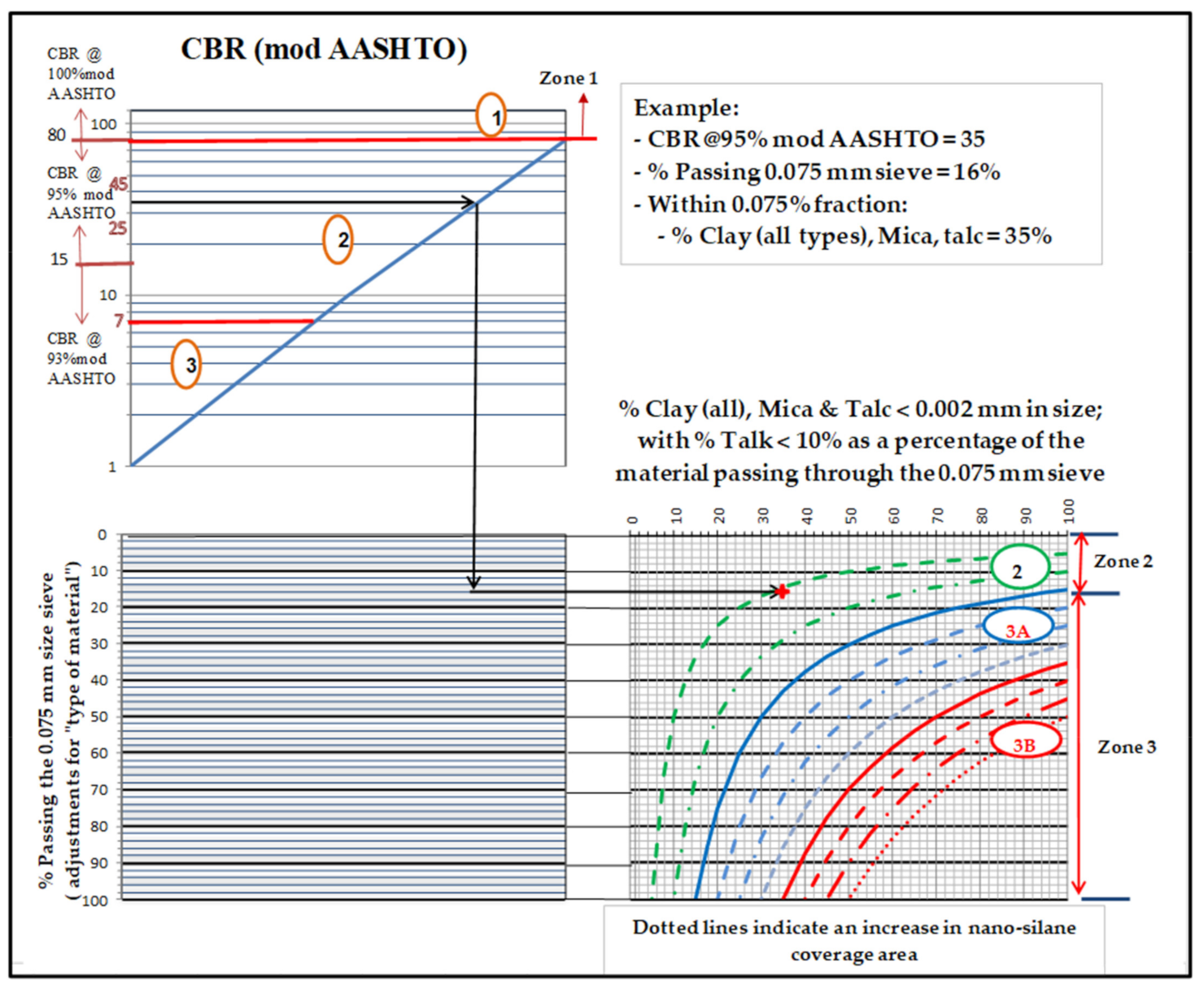

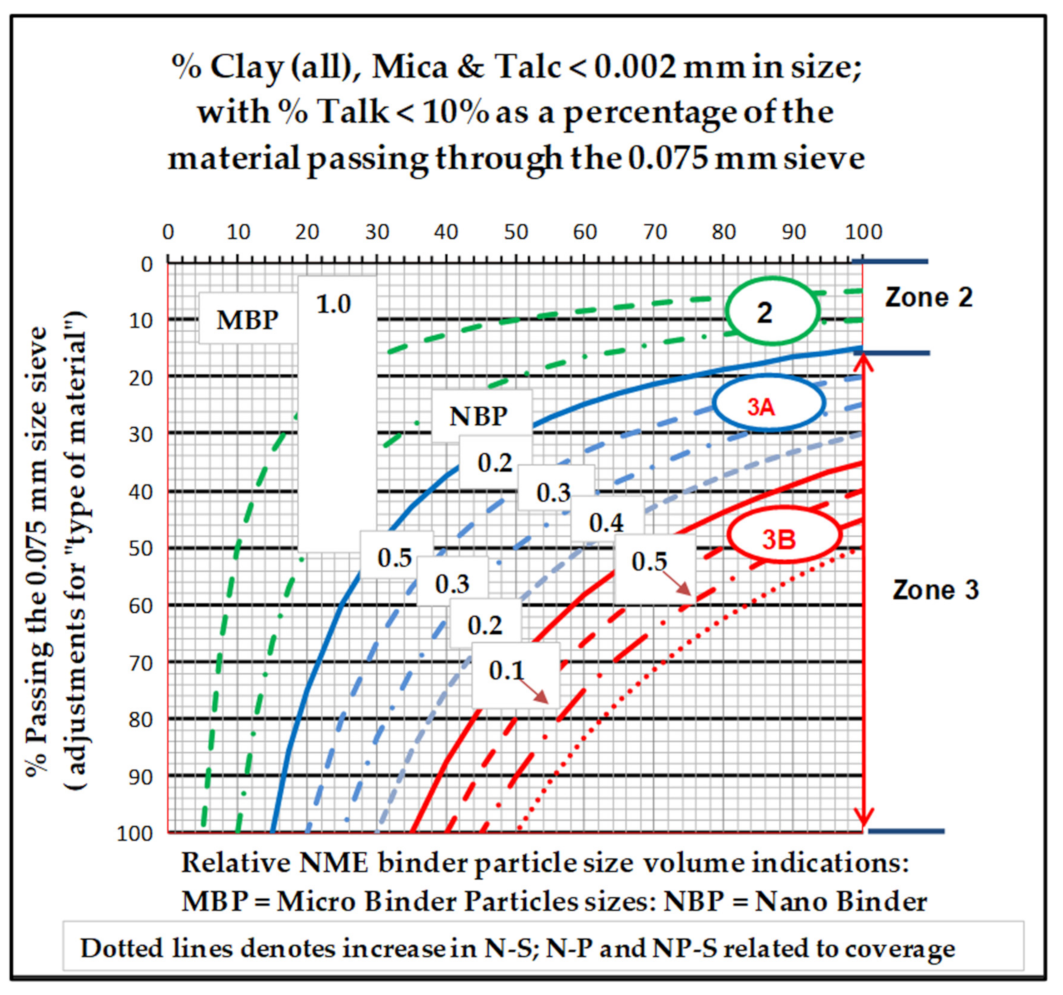
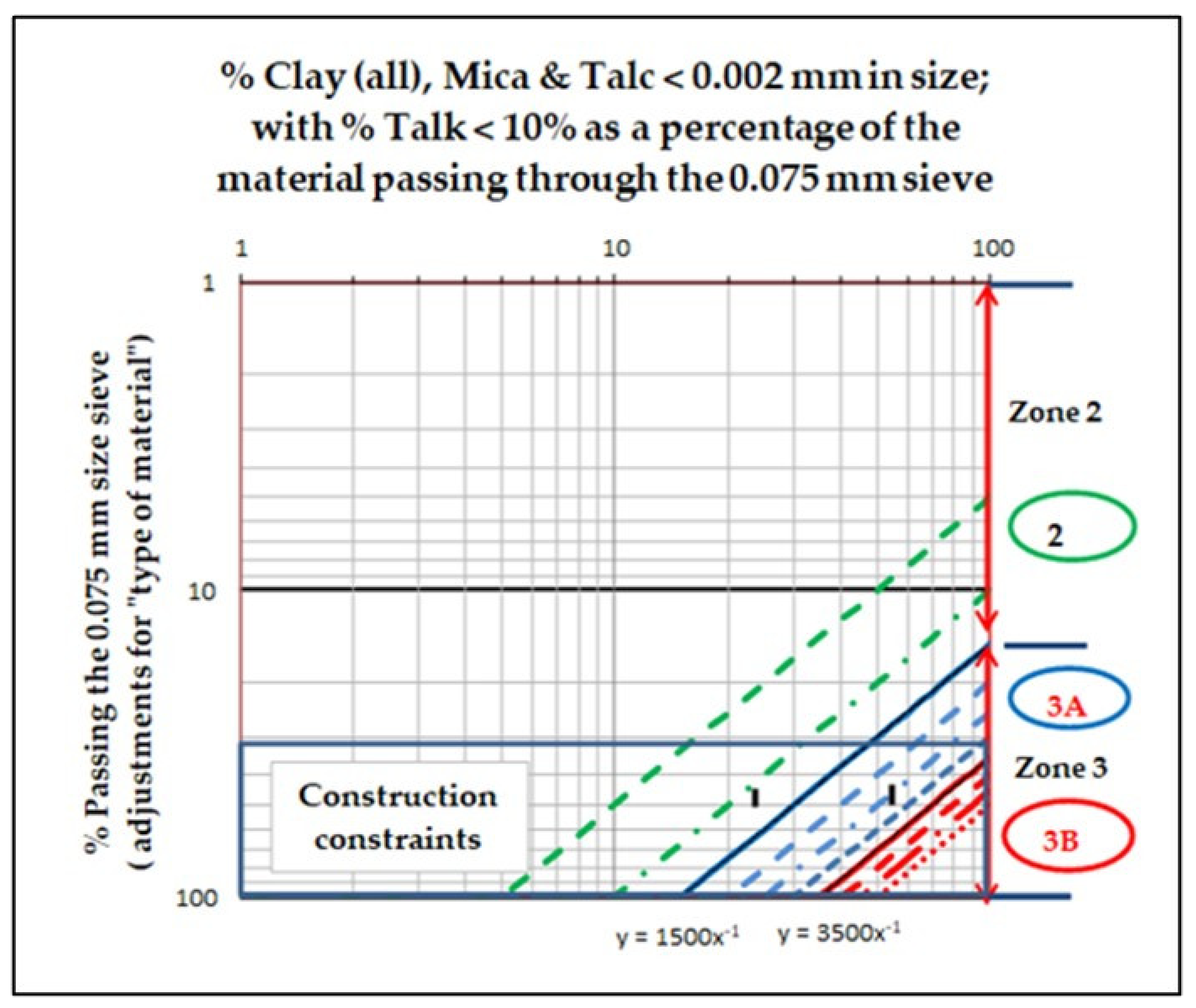

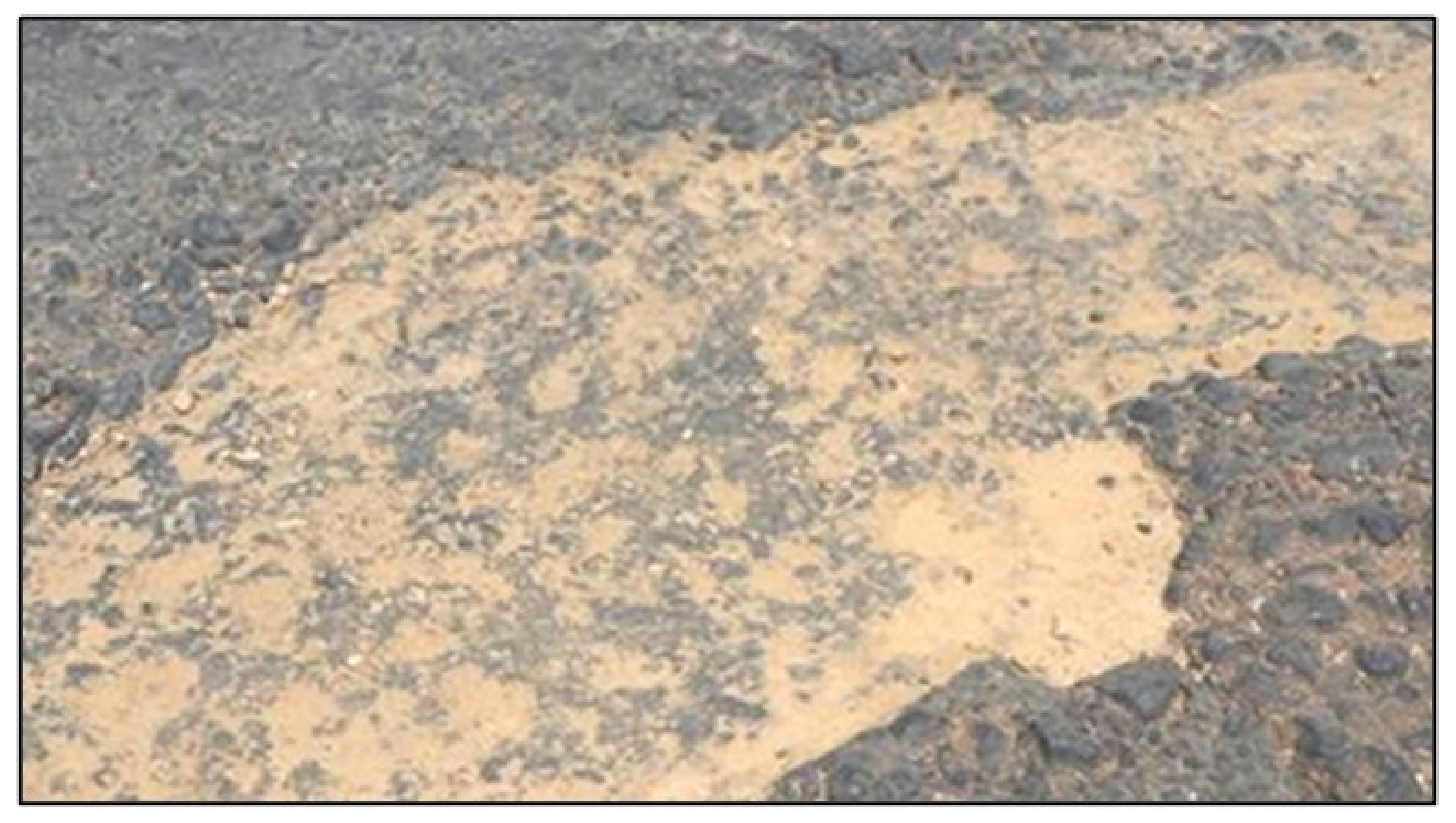

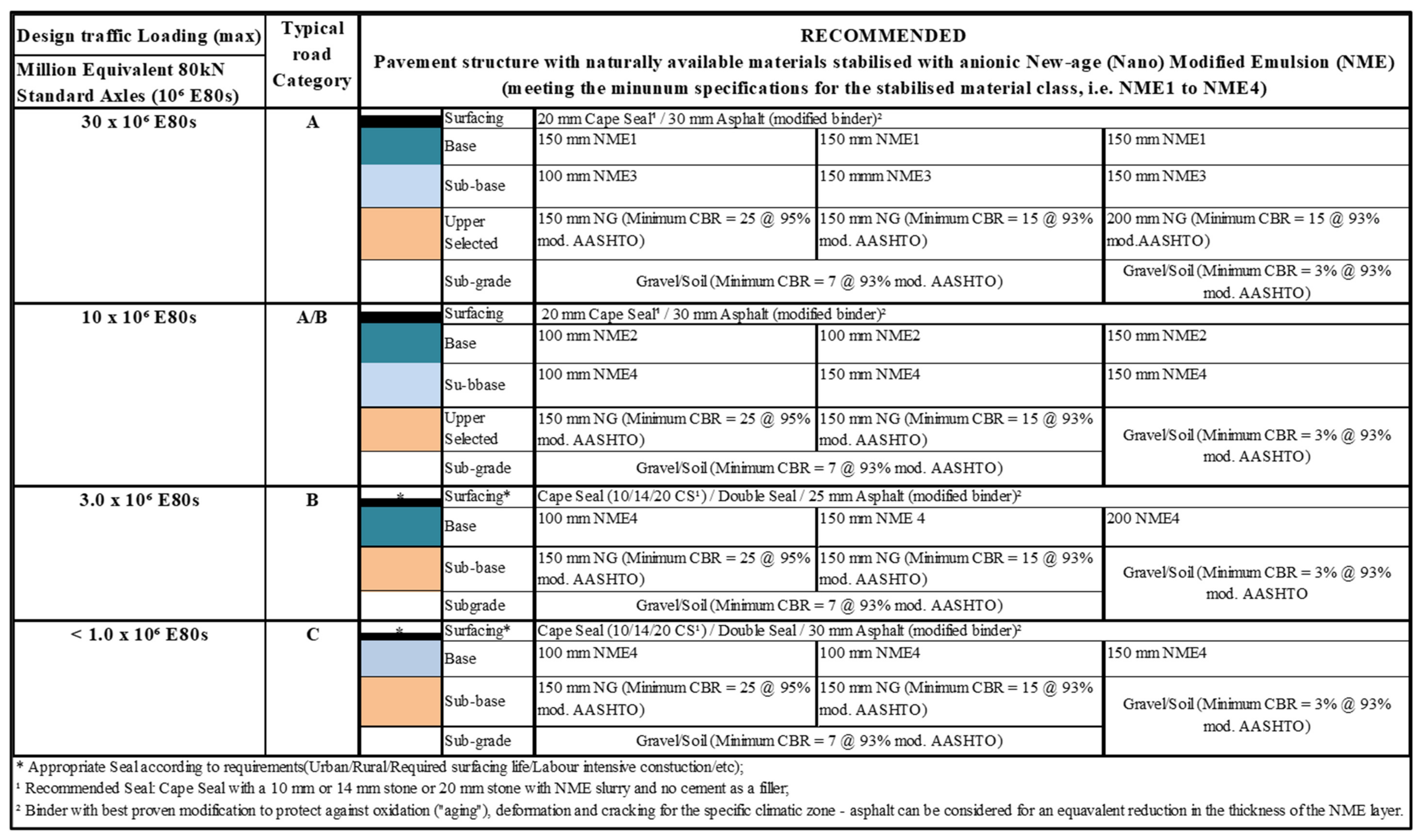

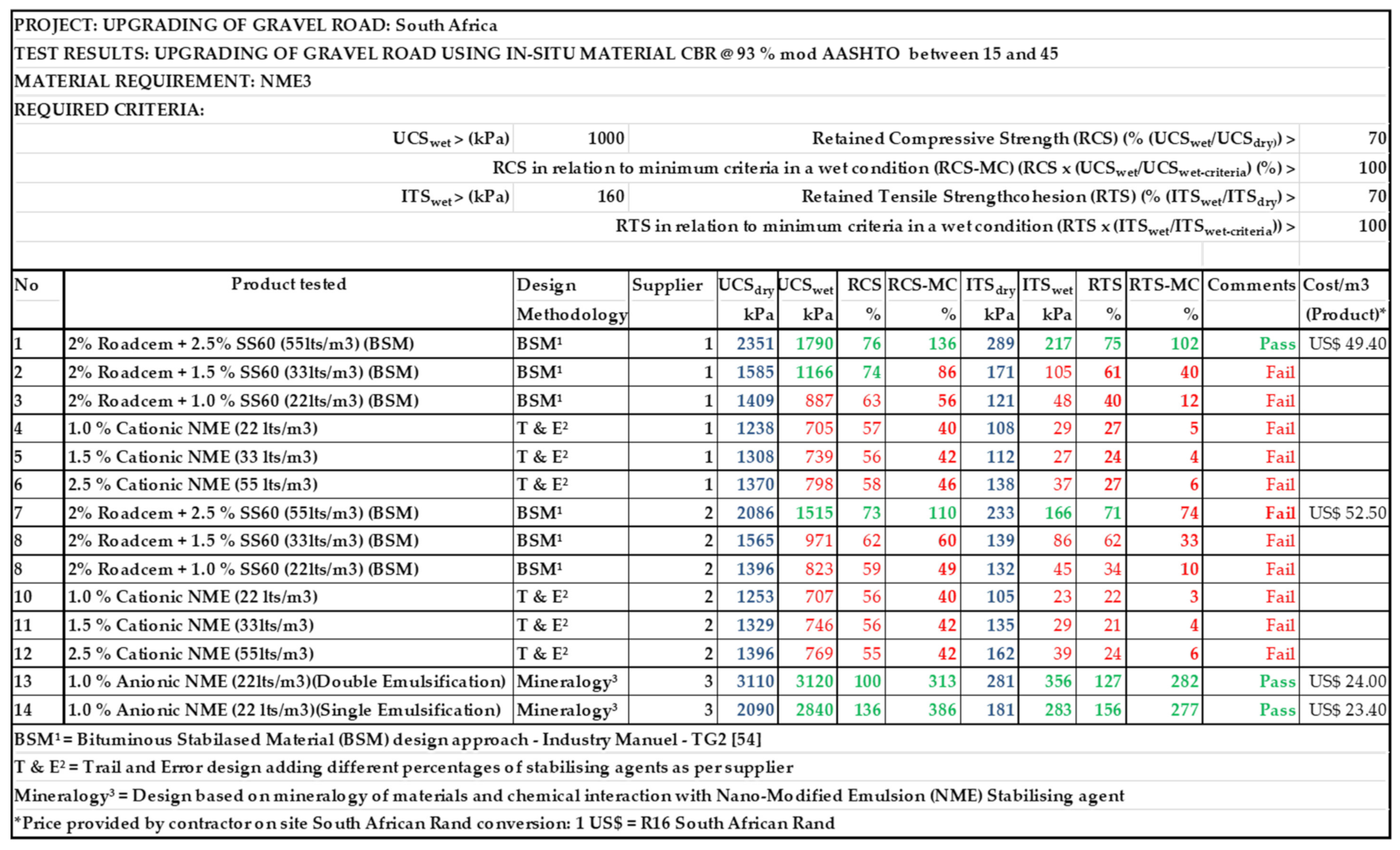
| Climatic Conditions | Cold Regions (Little Decomposition) | Warm Regions (Considerable Decomposition) |
|---|---|---|
| Property | Materials: Conventional (Crushed rock base, river gravels, glacier outwash) | Materials: Pedogenic (laterites, calcretes, ferricretes, silcretes, etc.) |
| Climate | Temperate to cold | Arid, tropical, warm temperate |
| Material Composition | Natural or crushed | Varies from rock to sand to clay with considerable variation in each |
| Material Chemical Reactivity | Inert | Reactive |
| Material Variability | Homogeneous | Extremely variable |
| Estimated % by Weight | Estimated Atomic % | Estimated Volume % | |
|---|---|---|---|
| Oxygen (O) | ~46.6–49.5 | ~62.3–66.2 | ~92–94 |
| Silicon (Si) | ~25.3–27.7 | ~19.4–21.2 | ~8–6 |
| Aluminium (Al) | ~7.5–8.1 | ~6.0–6.5 | |
| Iron (Fe) | ~4.2–5.1 | ~1.6–1.9 | |
| Calcium (Ca) | ~3.2–3.6 | ~1.7–1.9 | |
| Sodium (Na) | ~2.4–2.9 | ~2.0–2.4 | |
| Potassium (K) | ~2.3 - 2.6 | ~1.2–1.4 | |
| Magnesium (Mg) | ~1.9–2.1 | ~1.6–1.8 | |
| All Others | ~2.5 | ~0.5 | |
| Total | 100 | 100 | 100 |
| Mineral | % Albite (Na(AlSi3O8)) | % Anorthite (Ca(Al2Si2O8) |
|---|---|---|
| Albite | 100–90% Ab | 0–10% An |
| Oligoclase | 90–70% Ab | 10–30% An |
| Andesine | 70–50% Ab | 30–50% An |
| Labradorite | 50–30% Ab | 50–70% An |
| Bytownite | 30–10% Ab | 70–90% An |
| Anorthite | 10–0% Ab | 90–100% An |
| Component | % By Mass | Main Form of Occurrence |
|---|---|---|
| SiO2 | 5–70 | Quartz, feldspar, clay minerals |
| AL2O3 | 5–35 | Feldspar, clay minerals, gibbsite |
| * Fe2O3 | 5–70 | Goethite, hematite |
| TiO2 | 0–5 | Anatase, rutile |
| MnO | 0–5? | |
| P2O5 | 0–1 | |
| H2O+ | 5–20 | Clay minerals, goethite, gibbsite |
| Loss of Ignition | 5–30 | Clay minerals, goethite, gibbsite, organic matter |
| Organic Matter | 0.2–2 | Organic matter |
| Property | Type of Clay | ||||
|---|---|---|---|---|---|
| Smectite (Montmorillonite) | Vermiculite | Illite | Chlorite | Kaolinite | |
| Specific Area (m2/g) | 700–800 | 500–700 | 50–200 | 25–40 | 5–30 |
| External surface | Very High | Very High | Medium | Medium/low | Low |
| Basal spacing (Å) | 9.6–20 | 10–15 | 10 | 14 | 7.2 |
| Internal surface | Very High | High | Medium | Medium | None |
| Expanding | Yes | Slightly | No | No | No |
| Swelling capacity | High | Medium High | Medium | Low | Low |
| Cationic exchange capacity (CEC) (meq/100g) | 80–100 | 100–150+ | 10–40 | 10–40 | 3–15 |
| Similar clays | Beidellite Nontronite Saponite Bentonite | Mica Fe2O3 Fe(OH)3 Al(OH)3 | Halloysite Anauxite Dickite Nacrite | ||
| Material | Surface Area of Material (m2/g) | Comparative Surface Area with Relation to Silicate Materials |
|---|---|---|
| Glass | 0.1 to 0.2 | |
| Quartz (SiO2) | 1 to 2 | 1 |
| Calcium silicate (Ca2O4Si) | 2.6 | 1.3 |
| Calcium carbonate (CaCO3) | 5 | 2.5 |
Publisher’s Note: MDPI stays neutral with regard to jurisdictional claims in published maps and institutional affiliations. |
© 2021 by the authors. Licensee MDPI, Basel, Switzerland. This article is an open access article distributed under the terms and conditions of the Creative Commons Attribution (CC BY) license (https://creativecommons.org/licenses/by/4.0/).
Share and Cite
Jordaan, G.J.; Steyn, W.J.v. Nanotechnology Incorporation into Road Pavement Design Based on Scientific Principles of Materials Chemistry and Engineering Physics Using New-Age (Nano) Modified Emulsion (NME) Stabilisation/Enhancement of Granular Materials. Appl. Sci. 2021, 11, 8525. https://doi.org/10.3390/app11188525
Jordaan GJ, Steyn WJv. Nanotechnology Incorporation into Road Pavement Design Based on Scientific Principles of Materials Chemistry and Engineering Physics Using New-Age (Nano) Modified Emulsion (NME) Stabilisation/Enhancement of Granular Materials. Applied Sciences. 2021; 11(18):8525. https://doi.org/10.3390/app11188525
Chicago/Turabian StyleJordaan, Gerrit J., and Wynand J. vdM Steyn. 2021. "Nanotechnology Incorporation into Road Pavement Design Based on Scientific Principles of Materials Chemistry and Engineering Physics Using New-Age (Nano) Modified Emulsion (NME) Stabilisation/Enhancement of Granular Materials" Applied Sciences 11, no. 18: 8525. https://doi.org/10.3390/app11188525
APA StyleJordaan, G. J., & Steyn, W. J. v. (2021). Nanotechnology Incorporation into Road Pavement Design Based on Scientific Principles of Materials Chemistry and Engineering Physics Using New-Age (Nano) Modified Emulsion (NME) Stabilisation/Enhancement of Granular Materials. Applied Sciences, 11(18), 8525. https://doi.org/10.3390/app11188525






